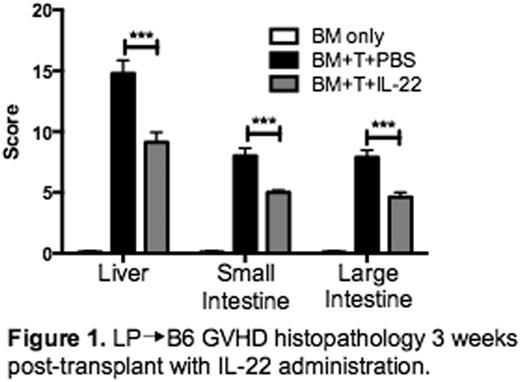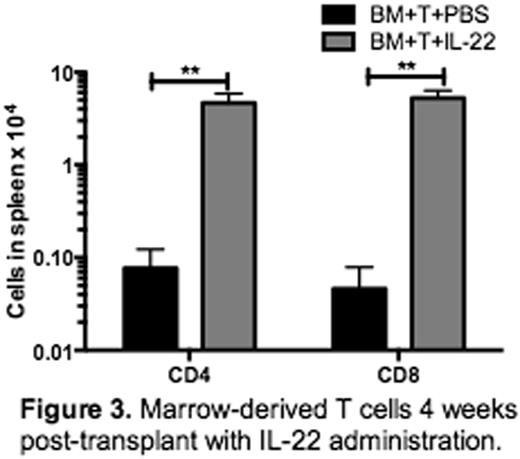Abstract
Mechanisms regulating host tissue recovery from immune-mediated damage in gastrointestinal graft vs. host disease (GI GVHD) remain incompletely understood. Prophylactic strategies selectively promoting epithelial regeneration after allogeneic hematopoietic stem/progenitor cell transplantation (allo-HCT) have the potential to reduce GVHD without limiting therapeutic graft vs. leukemia/lymphoma (GVL) responses.
We have previously shown that IL-22 produced by recipient-derived innate lymphoid cells (ILCs) provides a critical signal for epithelial recovery following experimental allo-HCT. IL-22-deficient recipients demonstrated increased GVHD mortality and significantly worse loss of crypt base intestinal stem cells (ISCs) during GVHD. Paradoxically, GVHD led to reduced GI IL-22 levels in wild-type (WT) recipients due to the elimination of radioresistant intestinal ILCs. We therefore sought to determine if IL-22 administration after allo-HCT could negate the effect of ILC elimination and reduce GVHD pathology without impairing GVL. We utilized a clinically modeled LP into C57BL/6 (B6) minor antigen mismatched model with T cell-depleted marrow and MACS-purified T cells transplanted into lethally irradiated mice. Recipients were treated daily with PBS or 4ug murine recombinant (r)IL-22 delivered via intraperitoneal (IP) injection starting day 7 post-HCT. This schedule was based on the results of rIL-22 pharmacokinetics tested in untransplanted mice.
We found that daily IP administration with rIL-22 led to decreased GVHD pathology in recipient small intestine, large intestine, and liver three weeks post-HCT (Figure 1, p<.001). No differences were observed in skin histopathology, consistent with our previous finding that IL-22-deficient recipients demonstrated equivalent skin GVHD. Further assessment of the intestinal pathology indicated that recipients of rIL-22 had decreased intestinal crypt apoptosis in both small and large intestine (p<.01) with no difference in intestinal lymphocytic infiltration, suggesting that the decrease in GVHD was due to direct effects of IL-22 on the epithelium. Furthermore, no differences were observed in splenic T cell expansion or in GI cytokine expression, including a multiplex panel of inflammatory cytokines.
To assess the effects of IL-22 administration on the ISC compartment, we performed LP into B6 allo-HCT using Lgr5-LacZ ISC reporter mice. Recipients treated with rIL-22 demonstrated increased numbers of Lgr5+ ISC three weeks post-HCT during active GVHD with no immunosuppression (Figure 2, p<.05). Preliminary evidence with Lgr5-GFP reporter mice suggested increased ISC Ki-67 staining and thus increased ISC proliferation following IL-22 administration. Small intestine qPCR after IL-22 treatment demonstrated increased expression of Reg3γ (p<.001) and Reg3β (p<.01), suggesting a potential antimicrobial benefit of IL-22 administration. However, there was no difference in Wnt3 or EGF expression, arguing that the stem cell benefit after IL-22 administration was not due to improvement in ISC niche function.
Given the lack of IL-22R expression in hematopoietic cells, we hypothesized that IL-22 administration would not limit GVL. This was confirmed by monitoring luciferase+ A20 bioluminescence in B6 into BALB/c tumor challenge recipients treated with rIL-22. Finally, we have previously shown that rIL-22 administration can increase the number of double positive thymocytes post-HCT by protecting thymic epithelium from radiation injury and from GVHD. We hypothesized that this could translate into improved peripheral T cell reconstitution even during active GVHD. Indeed, FVB into BALB/c MHC-mismatched transplant with Rag2-GFP marrow and WT T cells indicated that IL-22 administration increased the development of donor marrow-derived CD4 and CD8+ thymic emigrants four weeks post-HCT (Figure 3, p<.01).
In summary, we found that IL-22 administration could reduce intestinal pathology, improve ISC recovery, and promote donor marrow-derived T cell development during GVHD. Importantly, IL-22 administration did not impair GVL. These results suggest that post-transplant IL-22 administration represents a novel strategy to protect intestinal epithelium and improve immune reconstitution after allo-HCT.
No relevant conflicts of interest to declare.
Author notes
Asterisk with author names denotes non-ASH members.




This feature is available to Subscribers Only
Sign In or Create an Account Close Modal